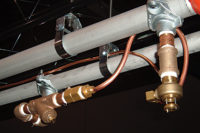Until recently, residential sprinkler systems were not an option for most homeowners because they were expensive, difficult to install, or their builder was too skeptical about sprinkler reliability. Thanks to a recent change in the residential fire protection standard NFPA 13-D, all of this is beginning to change. The new standard allows the use of 1/2" tubing in a combination plumbing/sprinkler system for one and two family homes. Prior to this change, residential sprinkler systems were required to use a minimum size of 1/2" pipe, and in almost all cases were separate from the plumbing system. The larger tubing and separate system were more difficult and expensive to install, and required a sprinkler installer.
The Wirsbo combination plumbing/fire sprinkler system is based on its 1/2" PEX (cross-linked polyethylene) tubing, used for over 25 years in radiant floor heating and plumbing systems. Wirsbo has obtained notification that it will be granted a patent on this combination plumbing/fire sprinkler system concept.
The Heart of the System: Four-Port Fittings
The Wirsbo system is based on the manifold installation concept. For over a decade, plumbers have been using manifolds to run direct water lines to each plumbing fixture. The manifold system saves installers time by eliminating the number of connections required in the system. Temperature and pressure fluctuations are also reduced.The Wirsbo plumbing/fire protection system adds sprinklers to the manifold plumbing system to form one interconnected grid. As such, the system is most logically installed by plumbers already familiar with the installation requirements for 1/2" PEX plumbing pipe. The sprinklers are easily added to the plumbing system with a specially designed, stainless steel fitting with four ports. This fitting connects directly to the sprinkler head, allowing each sprinkler to be fed by as many as four 1/2" PEX lines.
For plumbers looking for training on the installation aspects of a combination plumbing/fire sprinkler system, Wirsbo will be offering training courses around the country. In addition to requiring this training, some states also require plumbers to have a sprinkler license before installing residential sprinkler systems.
System Design is Key
To make installations simple for plumbers, Wirsbo provides design assistance with its system. The designers use a special computer software program that allows them to convert a set of blueprints into a detailed plumbing/sprinkler plan. By inputting information about room size, fixture and manifold locations, designers are able to create a CAD layout of the system, complete with hydraulic calculations and sprinkler head locations.By carefully following the design plan, installers can easily lay out the plumbing/sprinkler system. Typically, the cold water manifold will run direct lines to various four-port fittings attached to sprinkler heads. The remaining three ports are then used to feed other sprinkler heads or to feed cold water plumbing fixtures. Fire codes mandate that only one port on each fitting be used to feed a plumbing fixture. The other three ports must be fed by the manifold or other four-port fittings. The Wirsbo concept eliminates many of the following challenges faced by sprinkler system designers, builders, homeowners and developers.
1. Backflow preventers are eliminated.
Because the plumbing system and the fire sprinkler system are combined, stagnant water is eliminated. Each time a plumbing fixture is used, water throughout the system is moved and refreshed. The added cost and time associated with backflow preventers is no longer necessary.
2. Heat-activated heads eliminate accidental sprinkler discharge.
Homeowners do not have to worry that all of the sprinklers in their home will discharge at once. The Reliable" Sprinkler Heads used in the Wirsbo system are quick response, residential heads that are activated by heat, not smoke. Contrary to popular belief, the heads will not discharge unless they sense temperatures greater than 155iF. In fact, over 97% of home fires are put out with just one sprinkler head, leaving the other heads completely untouched.
3. Lives and property are saved.
Although the vast majority of homes now contain smoke alarms, smoke alarms used in conjunction with residential sprinklers can increase the occupant's chance of escape from 50% to 90%. A room can become engulfed in flames in just four minutes. In less time than it would take most fire departments to arrive on the scene, sprinklers can contain and extinguish a fire.
4. Water is saved.
Residential sprinklers control fires with a fraction of the water used by fire department hoses, reducing the cost and necessary capacity for water storage. Sprinklers activate during the early stages of a fire, before the fire department can arrive. The sprinklers in the Wirsbo system discharge between 10 and 15 gallons of water per minute. Fire hoses, in contrast, use as much as 125 gallons of water per minute.
5. Sprinklers reduce the strain on a city's fire fighting resources.
Cities like Scottsdale, AZ, that have mandated residential fire sprinklers have been able to grow by as much as 30% without corresponding growth in their fire fighting resources. This allows for additional investments in fire education and training.
6. Costs are reduced.
The combined system uses 1/2" tubing and does not require a separate sprinkler installer. This reduces the cost and time associated with the sprinkler installation, putting residential fire sprinklers in the same category as other common home upgrades, such as lighting, carpet and fixtures.
Cities around the country are beginning to mandate residential fire sprinklers in newly constructed homes. As they learn more about the life saving benefits of these systems, not to mention the intuitive benefits for builders and developers, fire chiefs around the country will continue to follow the current trend leaning toward combination plumbing/fire sprinkler systems. Mandating residential sprinkler systems was costly for builders in the past, but with the combination plumbing/fire sprinkler system, builders can offer their customers reliable fire protection at a fraction of the cost for a standalone sprinkler system installed by a sprinkler installer.
